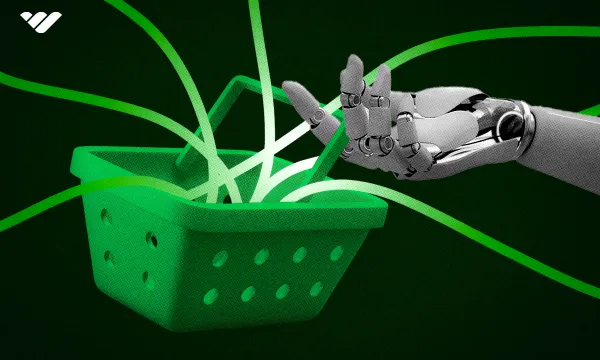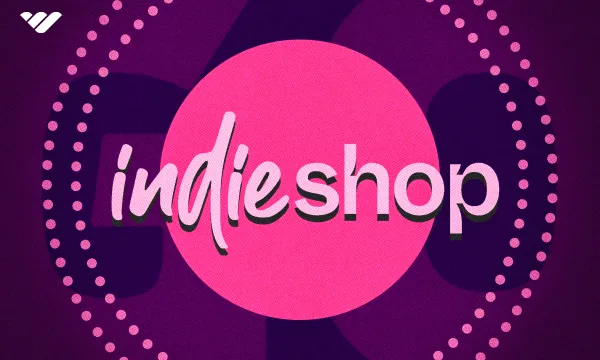Dropshipping is a popular online business model, and for good reason. It gives you the ability to test new products, marketing angles, and brand ideas without having to actually purchase and store inventory. It’s one of the original online ecommerce strategies!
However, it’s not perfect by any means. In this guide, we’ll be covering what dropshipping is, how it works, other questions you may have, and pros and cons of this business operation.
If you know what you're looking for, then jump ahead to:
- What is Dropshipping?
- Does Dropshipping Actually Work?
- What Tools Are Needed For Dropshipping?
- What Options Are There Other Than Dropshipping?
- 👍 Pros of Dropshipping
- 👎 Cons of Dropshipping
- Dropshipping in 2024: Is it Worth it?
- Dropshipping FAQs
What is Dropshipping?
Dropshipping is an online business in which a seller or store owner sources individual products from a supplier and sells them online through a branded storefront. But, rather than buying the products in bulk and shipping them out like traditional brands do, the seller is simply marketing the products while the supplier handles the storage, packing, and fulfillment.
In dropshipping, the seller markets the products while the supplier ships them.
Compare this to a typical ecommerce business where a seller creates or innovates on an existing product, customizes it with their logo and specs, buys the inventory upfront, manages the stock, and then ships the orders themselves.
Dropshipping allows the store owner to do less work and focus solely on branding and advertising, while the supplier manages the operations and staffing needed to get goods out the door. From a cash flow perspective, dropshipping is more beneficial to sellers because the only time that they need to buy an item is when it’s already been purchased by a customer.
The only capital risk that the seller has is any initial investment (Shopify website, branding, etc.) and then the money they spend on marketing (Facebook ads, SEO, etc.), or the customer acquisition costs. For more on dropshipping, check out our complete guide.
Does Dropshipping Actually Work?

While it’s sometimes viewed as a controversial business model because the brand doesn’t ever handle the actual products, the reality is that many businesses operate on a dropshipping model. For instance, some items on marketplaces like Walmart or Amazon aren’t fulfilled by those retailers, but rather the sellers who are simply placing a listing on the site.
In this example, those retailers are acting as the dropshipper while the brand is operating as the supplier. Dropshipping certainly works for plenty of businesses, but it’s not easy and takes time to create a functioning system.
The real way to make dropshipping work is to have better branding, better marketing campaigns, better customer service, and ultimately, better margins. Because there are so many parties in the value chain, it’s important that the seller is profitable once the product has been delivered and all the expenses have been covered.
To make dropshipping work, play to your advantages (whether it’s creative or media buying) so that you can charge customers enough to run a profitable business.
What Tools Are Needed For Dropshipping?
Thankfully with dropshipping, all the tools that you need are already built and readily available for relatively low fees. Here is the software and services that you’ll need to get started, along with what they do:
Shopify
Shopify is the leading physical-product ecommerce storefront platform. It allows you to create product pages, accept payments, and do plenty of other things needed to run an online business.
This tool is essentially the front end of your business — where you’ll send customers to buy items, get product information, and send support messages.
AliExpress
AliExpress, a subsidiary of Chinese ecommerce giant Alibaba, is a product discovery platform that allows you to find winning products and the suppliers who produce them. The number of items available is essentially limitless.
This tool is a catalog of the thousands of products that you can offer customers through your store.
AutoDS or Oberlo
AutoDS and Oberlo are automation tools that let you sync your Shopify site with AliExpress’s backend. They have features like importing products to your store, price monitoring, and automated order fulfillment. These tools make a lot of the operations of your business effortless.
This tool connects your front-end Shopify site with the backend AliExpress supplier network.
Meta Ads Manager
Meta Ads Manager, formerly known as Facebook Ads Manager, is the platform you use to run ads on social networks like Facebook and Instagram. (Also known as “driving traffic.”) With Ads Manager you can load creative assets, ad copy, and target certain audiences.
This tool is the primary way for you to acquire new customers and teach them about what your product does.
Canva or Photoshop
Photo-editing and graphic creation software like Canva and Photoshop are how you’ll make ad creatives to use in your ad campaigns. You can create static images from supplier images or your own photoshoots, as well as add text and icons.
This tool is how you make compelling content for ad campaigns that gets a lot of clicks, comments, and engagement.
Other Software to Keep in Mind
While the above are the most necessary basics, there are dozens of other helpful tools that more advanced dropshippers take advantage of. Analytics tools like Google Analytics help you monitor your site’s visitor data, email marketing platforms like Klaviyo and Sendlane help you communicate with customers, and SMS providers like Postscript and Attentive let you text customers updates on their orders and marketing promotions.
Understand what the most important parts of your business are before investing time and energy into more advanced metrics.
What Options Are There Other Than Dropshipping?
If you’re looking to start an ecommerce business, dropshipping isn’t the only route to take. For physical goods, you could also start a long-term brand based on a personal story or big need you see in everyday life. This process is more in-depth, requires more investment and energy, but it also has massive upside potential.
Here is what’s involved in creating your own ecommerce brand:
- Decide on the product or niche
- Find wholesale suppliers to manufacture or customize your goods
- Buy inventory and either ship it yourself or find a third-party logistics company
- Set up a Shopify store and create a brand, logo, etc.
- Run marketing campaigns that feature your products and send them to your Shopify site
- Fulfill orders, accept returns and exchanges, and provide customer support
- Keep existing customers for the long term with email and SMS marketing campaigns
- Launch new products that will excite your audience and generate new demand for your brand
As you can see, there’s a lot more work in starting your brand, but the margins can be higher and your business could last a lot longer compared to dropshipping a trendy product. You also create the opportunity to have a cash-flowing asset that investors or buyers will be willing to pay for a piece of.
If you prefer to stay away from physical products completely and want a more hands-off approach, then digital products are the way to go. Digital products like ebooks, courses, and communities allow you to sell something you already own: Your information and knowledge.
Top digital ecommerce sites like Whop let you easily create a storefront, instantly fulfill orders and manage subscriptions, run communities, and get easy access to customers through a marketplace of engaged buyers.
Whop offers:
- Low transaction fees (which means higher margins and more profit for you)
- Easy-to-make storefronts with pre-built templates and beautiful user interfaces
- Around-the-clock customer support, every day of the week
- Team of advanced developers to help you with the technical components of your business
- Plus much, much more to help you build a sustainable online business
👍 Pros of Dropshipping
Let's say you're still considering dropshipping as the ecommerce business model for you. Dropshipping has numerous benefits that we’ll cover:
- It’s easy to get started.
- The technology is already built.
- You can do everything remotely.
- It’s scalable.
- You can target existing demand.
It’s easy to get started
Within just a few hours you can set up a store on Shopify, find products through AliExpress, connect your store with a tool like AutoDS, launch a Facebook campaign, start driving traffic to your shop, and hopefully, get actual orders.
If there are parts that you don’t know how to do, you can easily find the answers on YouTube or even hire a freelancer on sites like Upwork. If you’re looking for an easy way to get all the information you need and a community of like-minded people, check out one of our dropshipping courses on Whop.
The technology is already built
Because dropshipping has been around for so long, all of the tools you need are already in existence. If you were starting out 10 or so years ago, it would’ve been much more difficult to start an online store and connect with overseas suppliers.
But today, it’s already built and for just a few dollars you can have cutting-edge technology at your fingertips that helps you move fast and efficiently.
You can do everything remotely
With dropshipping, the store owner isn’t the one handling the product or fulfilling orders, so in theory, you could be anywhere in the world and run a dropshipping business. This means that you could live in your preferred location and you’re not tied down to a big city with high cost of living because you have to be in an office every day.
The one aspect that may be a challenge is taking photos and videos of your products for product description pages and ad creative. However, there are platforms that help you find creators who can make the content for you if you send them your products.
It’s scalable
Dropshipping isn’t a business-to-business service where you’re trading your time for money. You can scale it to potentially hundreds of orders per day with the right unit economics and strategies because your product is a physical item and your total addressable market is the billion of people shopping online.
But keep in mind that in order to grow your business, you need to invest in more ad creatives, higher campaign budgets, and reaching new audiences. Scaling a dropshipping business isn’t as simple as just buying more ad slots.
You can target existing demand
When you do product research you’re not looking for products that have the most advanced technologies or niche communities. You’re trying to find industries that already have a ton of demand so that you can easily find customers.
Use tools like Amazon and Google Trends to find products that already have growing interest and other brands are already making money with.
👎 Cons of Dropshipping
But it’s not without its disadvantages. Here are the cons of dropshipping:
- It’s hyper-competitive
- It’s not sustainable
- You’re not building a sellable business
- It has low margins
- Your products may not be the highest quality
It’s hyper-competitive
Because of the pros of dropshipping listed above, there are a lot of other people trying to start dropshipping businesses. This means that there’s a lot of competition that is competing on either lower prices or differentiated products.
It’s not sustainable
While you’re often selling products that serve a genuine need in everyday life, you could still be capitalizing on current social media trends. Because of this, the amount of people looking for your product could drastically decrease from season to season — or even week to week. Dropshipping is known for its peaks and valleys, so be mindful that you probably won’t be able to sell a single product for years to come.
You’re not building a sellable business
Unless you’re creating a long-term brand, you won’t have consistent revenue. Dropshipping businesses are rarely sellable because the revenue isn’t consistent or forecastable.
It has low margins
Everyone involved in the sourcing, production, fulfillment, and technology requires payment. Once you’ve paid for the cost of goods, the shipping, and the customer acquisition costs, you’re not left with a massive profit. Calculate what your selling price needs to be for you to build a profitable business. The last thing you want is to put in all the effort to get a site live only to find out that you’re breaking even, or losing money, when sales actually start to come in.
Your products may not be the highest quality
Products that are sold through dropshipping are known to generic, non-branded products that are sourced inexpensively. It’ll be hard to compete with established brands who have great name recognition and still make good money with dropshipping.
Dropshipping in 2024: Is it Worth it?
Dropshipping is an exciting business model that is easy to start and doesn’t require a ton of upfront capital. There are a ton of advantages such as the ability to work anywhere, the little-to-no amount of manual labor, and its ability to scale.
Keep in mind, there are certainly challenges with dropshipping like the high level of competition and its lack of sustainability, but when done right, it can be a massively profitable venture.
As with any venture, knowledge is power, so why not give yourself the best chance at success by joining a dropshipping community on Whop? Whop is home to expert communities where you can learn the ins-and-outs of dropshipping from experienced entrepreneurs. From private Discord groups to online courses and live events, there's something for every aspiring dropshipper.
Visit Whop to learn from dropshipping experts and like-minded students today!
Dropshipping FAQs
What is the hardest thing about dropshipping?
The hardest part about dropshipping isn’t finding suppliers or running ads, but doing so while still making a profit. Facebook ads work like an auction; when more people are bidding on ad slots, the price goes up.
The hardest part of dropshipping is being profitable among competition.
With the level of competition, more people will be willing to spend more on Facebook ads, so your customer acquisition cost will be higher. The combination of sellers competing on price, all of the associated costs, and Facebook marketing becoming more expensive makes profitable products the biggest challenge in dropshipping.
Is dropshipping legal?
Absolutely, dropshipping is 100% legal. Most of the time, you’re finding generic products from a platform like AliExpress and putting your own brand or logo on them, or selling them as is. The only time you may run into issues is if the supplier is in violation of patents or copyrights and selling products that existing brands already have the rights to.
When choosing a supplier, make sure that they are reputable, have been in business for a long time, and have positive reviews from past customers. Shy away from sellers that don’t have any history of orders.
Do I have to use Shopify for dropshipping?
While Shopify is the most popular physical ecommerce platform, you don’t have to use it to start a dropshipping business. Other store builders like WooCommerce and BigCommerce also give you the ability to connect your store with suppliers in a similar manner as Shopify.
Additionally, if you don’t want to manage the store yourself, you can use ecommerce marketplaces like eBay and Amazon to create product listings instead of having your own store. This is beneficial as you’ll get access to existing customers looking for the products you’re selling rather than being responsible to driving traffic to your own store.
How do I get started with dropshipping?
Getting started with dropshipping is easy. It only requires a computer, minimal capital, a few software tools, and your entrepreneurial mindset.
If you don’t know where to start, check out Whop. We have courses on dropshipping like Jordan’s Library and The Yard that also have engaged Discord communities with access to experts, resources, and mentorship.





